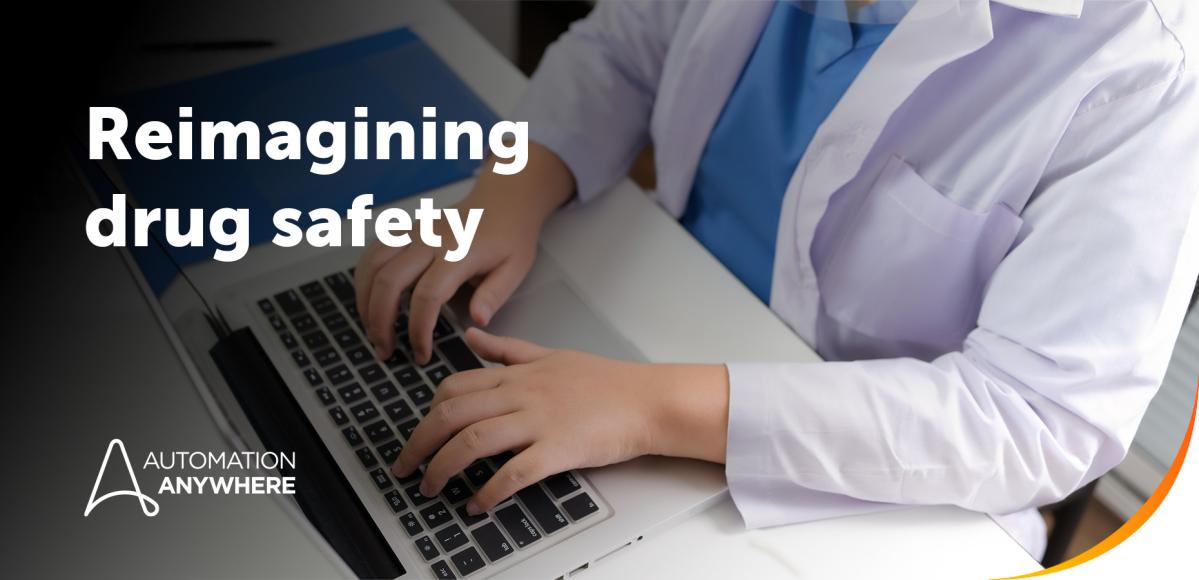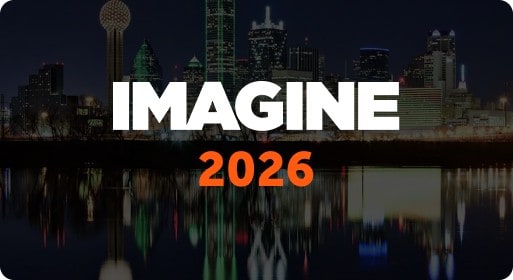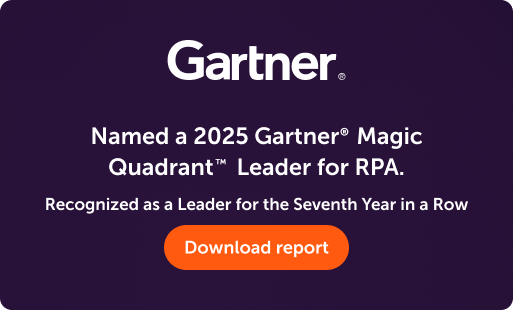- Login
- Search
- Contact Us
-
Have a question? Our team is here to help guide you on your automation journey.
-
Explore support plans designed to match your business requirements.
-
How can we help you?
-
- AI
AI Without the Hype From pilot to full deployment, our experts partner with you to ensure real, repeatable results. Get Started
- Automation Anywhere AI
-
- Solutions
Featured Agentic Solutions
Accounts Payable Invoice automation—No setup. No code. Just results. Accounts Payable
Customer Onboarding Scale KYC/AML workflows. Customer Onboarding
Customer Support Keep queues moving, even at peak load. Customer Support
Healthcare RCM Revenue cycle management that runs itself. Healthcare RCM
- Products
Platform Features
- Agentic process automation (APA)
- Robotic Process Automation (RPA)
- View all Products
-
- Resources
Get Community Edition: Start automating instantly with FREE access to full-featured automation with Cloud Community Edition.
Featured
 Named a 2025 Gartner® Magic Quadrant™ Leader for RPA.Recognized as a Leader for the Seventh Year in a Row Download report Download report
Named a 2025 Gartner® Magic Quadrant™ Leader for RPA.Recognized as a Leader for the Seventh Year in a Row Download report Download report- Become an Expert
- Developer Tools
- Get Support
- View all resources
-
- Partners
Find an Automation Anywhere Partner Explore our global network of trusted partners to support your Automation journey Find a Partner Find a Partner
- Find a Partner
- For Partners
-
Blog
How AI Agents Power the Next Generation of Pharmacovigilance
Navigate to content
- What are AI agents in pharmacovigilance?
- Why traditional PV workflows fall short
- The evolution of automation in pharmacovigilance
- 8 ways AI agents are transforming pharmacovigilance
- What to look for in an APA platform for pharmacovigilance
- How Automation Anywhere powers AI agents for pharmacovigilance
- A new era for pharmacovigilance
- FAQ
- How does agentic process automation (APA) differ from traditional RPA and gen AI tools in pharmacovigilance?
- Are AI-driven pharmacovigilance processes accepted by regulators?
- How do AI agents ensure privacy and compliance when handling patient data?
- What measurable impact can PV teams expect after implementing AI agents?
- How can organizations meet regulatory validation requirements with AI agents?
- What integration capabilities should APA platforms offer for pharmacovigilance?
- How do AI agents stay aligned with evolving regulatory requirements?
- What skills and changes are needed to implement AI agents successfully?

- What are AI agents in pharmacovigilance?
- Why traditional PV workflows fall short
- The evolution of automation in pharmacovigilance
- 8 ways AI agents are transforming pharmacovigilance
- What to look for in an APA platform for pharmacovigilance
- How Automation Anywhere powers AI agents for pharmacovigilance
- A new era for pharmacovigilance
- FAQ
- How does agentic process automation (APA) differ from traditional RPA and gen AI tools in pharmacovigilance?
- Are AI-driven pharmacovigilance processes accepted by regulators?
- How do AI agents ensure privacy and compliance when handling patient data?
- What measurable impact can PV teams expect after implementing AI agents?
- How can organizations meet regulatory validation requirements with AI agents?
- What integration capabilities should APA platforms offer for pharmacovigilance?
- How do AI agents stay aligned with evolving regulatory requirements?
- What skills and changes are needed to implement AI agents successfully?
Pharmacovigilance is critical to drug safety, but it’s struggling to keep up.
As adverse event reports surge, traditional pharmacovigilance (PV) methods are showing their age: they’re manual, slow, and error-prone. AI agents are changing that. By combining intelligence and autonomy, they’re transforming how life sciences organizations manage drug safety, ensure compliance, and protect patients. In this blog, we’ll explore what’s broken in today’s PV workflows—and how agentic process automation (APA) is helping fix it.
What are AI agents in pharmacovigilance?
AI agents are action-ready, autonomous assistants built to handle the complexity of drug safety monitoring. Unlike traditional bots that follow rigid rules, these agents use machine learning and natural language processing (NLP) to interpret data, make context-aware decisions, and adapt to new information—just like a human would. They can carry out multi-step tasks across systems, bringing speed, consistency, and intelligence to historically manual pharmacovigilance workflows.
All of this is powered by agentic process automation (APA)—a framework that combines AI, automation, and orchestration to help organizations scale PV operations, minimize human error, and stay compliant.
Why traditional PV workflows fall short
Manual pharmacovigilance processes aren’t just slow—they’re risky. As report volumes grow, these challenges become harder to ignore:
- ICSR intake delays: Manually processing thousands of Individual Case Safety Reports eats up time and budget—and slows response to critical events.
- Bottlenecks in narrative writing and coding: Generating case narratives and applying MedDRA codes by hand is resource-heavy and error-prone.
- Poor case triage: Without automation, assessing seriousness and urgency is inconsistent—delaying detection of potential safety signals.
- Compliance risks: When reporting is manual, mistakes happen. That puts companies at risk of missing regulatory deadlines or failing audits.
These issues make a strong case for moving beyond legacy systems—and toward intelligent, automated solutions built for scale.
The evolution of automation in pharmacovigilance
Pharmacovigilance has long been a manual, resource-intensive function. From case intake to signal detection and regulatory reporting, every step has traditionally required human effort—and with large pharma companies processing 100,000+ adverse event reports a year, that effort adds up. High error rates, compliance risks, and operational bottlenecks are common.
Then came automation, but not all automation is created equal.
Phase 1: Rules-based automation
Early automation tools handled specific tasks like data entry or narrative drafting. But these systems followed fixed rules and couldn’t adapt to real-world variability. As regulations evolved, so did the complexity, leading to fragmented workflows and new inefficiencies.
Phase 2: Smarter tools with ML and NLP
Machine learning and natural language processing brought incremental gains. These tools could support literature screening, detect duplicates, and suggest coding. But they still relied heavily on human oversight and couldn’t manage processes end-to-end.
Phase 3: Agentic process automation (APA)
Now, a new generation of automation is taking hold. APA combines generative AI, process intelligence, and orchestration to enable truly autonomous operations. AI agents built on APA don’t just assist—they act. They make context-driven decisions, move between systems, and handle entire workflows with minimal human input.
This is the future of pharmacovigilance—and it’s already here.
8 ways AI agents are transforming pharmacovigilance
AI agents are reshaping drug safety—from intake to submission. These intelligent, autonomous systems reduce manual workload, improve compliance, and help PV teams focus on what matters most: protecting patients.
Here are eight high-impact use cases:
- Smart case intake
AI agents monitor emails, call centers, and online portals, extracting structured data from unstructured sources. They detect duplicates, triage reports, and slash processing times. - Automated literature screening
Agents continuously scan scientific publications, assess relevance, and route findings into workflows—so no critical signal slips through the cracks. - Medical coding with context
By understanding case details, AI agents suggest accurate MedDRA codes, improving coding consistency and reducing rework. - Real-time case triage
AI agents assess case seriousness, validity, and urgency—then prioritize accordingly to accelerate response and ensure regulatory compliance. - Regulatory-ready narratives
Agents auto-generate and format case narratives, then perform quality reviews to confirm compliance before submission. - Continuous signal monitoring
With built-in analytics, AI agents monitor safety databases 24/7 to flag emerging risks and reduce false positives. - Submission automation
Agents track deadlines, validate data, and prep regulatory submissions across regions—cutting delays and reducing risk. - Cross-team coordination
AI agents keep PV, clinical, regulatory, and quality teams aligned—sharing context and accelerating collaboration across silos.
Together, these use cases show how AI agents go far beyond point solutions. They work across systems, teams, and workflows to automate what once required hours of manual effort, without sacrificing accuracy or compliance. As adoption scales, AI agents won’t just support pharmacovigilance teams—they’ll help redefine what’s possible in drug safety.
What to look for in an APA platform for pharmacovigilance
Not all automation platforms are built for life sciences. To fully realize the benefits of AI agents in pharmacovigilance, organizations need an agentic process automation (APA) platform with the right capabilities.
End-to-end process orchestration
The platform should coordinate workflows across the entire PV lifecycle—from intake to submission—integrating seamlessly with safety databases, medical coding tools, and regulatory systems. It must handle complex logic without creating silos.
Intelligent document processing
From literature and medical records to emails and call transcripts, the system must extract relevant data accurately while maintaining context across multiple document types.
Built-in compliance framework
To meet regulatory standards, the platform should offer audit trails, version control, and change management. These capabilities are essential for validation and transparent oversight.
Human-agent collaboration
AI agents shouldn’t work in isolation. Look for platforms that support intuitive handoffs and human-in-the-loop (HITL) validation—helping teams guide, monitor, and continually improve autonomous processes.
Enterprise-grade security
Handling sensitive patient data demands rigorous protection. The platform must support HIPAA, GDPR, and other compliance standards with robust access controls and data safeguards.
With the right foundation, organizations can scale safely, accelerate implementation, and confidently deploy AI agents across high-stakes drug safety workflows.
How Automation Anywhere powers AI agents for pharmacovigilance
Automation Anywhere is leading the charge in agentic process automation for life sciences, offering a platform purpose-built to simplify complex drug safety workflows. Our technology helps pharmacovigilance teams break down silos, boost compliance, and scale safely with AI agents designed for real-world challenges.
Here’s how our Agentic Process Automation System delivers:
- Automation Co-Pilot: Empowers pharmacovigilance specialists to build and deploy AI agents tailored to their workflows, without needing deep technical expertise.
- Document Automation: Accelerates intake by extracting relevant data from literature, medical records, emails, and more—ensuring accuracy and speed at scale.
- Process Discovery: Uncovers inefficiencies in case processing and identifies opportunities for automation, streamlining operations from intake to reporting.
- End-to-end orchestration: Connects safety databases, regulatory systems, and clinical platforms to manage workflows holistically—no manual patchwork or disconnected tools.
A new era for pharmacovigilance
AI agents aren’t just digitizing PV—they’re redefining it. With agentic process automation, life sciences teams can move faster, reduce compliance risk, and free up experts to focus on strategic, high-impact work. The organizations leading the way won’t just keep up with change—they’ll shape what comes next.
Want to see it in action? Check out our on-demand webinar to explore how AI agents are transforming pharmacovigilance—from intake to insight.
FAQ
How does agentic process automation (APA) differ from traditional RPA and gen AI tools in pharmacovigilance?
APA brings together AI, automation, and orchestration to enable end-to-end, autonomous workflows—not just task-level automation. Unlike traditional RPA, which follows rigid rules, or standalone generative AI tools, APA empowers AI agents to make context-driven decisions, move across systems, and adapt as inputs change. It’s not just about digitizing PV—it’s about reimagining how the work gets done.
Are AI-driven pharmacovigilance processes accepted by regulators?
Regulators are increasingly recognizing the role of AI in improving safety and compliance. While formal guidance is still evolving, many agencies support innovation—as long as organizations demonstrate control, transparency, and validation. AI agents must operate within a documented, auditable framework that aligns with current regulatory expectations.
How do AI agents ensure privacy and compliance when handling patient data?
AI agents are designed with enterprise-grade security baked in. This includes data encryption, access controls, and audit trails that support compliance with global regulations such as HIPAA, GDPR, and regional pharmacovigilance standards. A robust APA platform helps ensure sensitive data is processed securely, accurately, and responsibly.
What measurable impact can PV teams expect after implementing AI agents?
Organizations typically see a 40–60% reduction in case processing time, fewer errors in MedDRA coding and narrative generation, and more efficient regulatory submissions. These gains translate to cost savings, improved compliance, and faster response to emerging safety signals—ultimately helping protect patients more effectively.
How can organizations meet regulatory validation requirements with AI agents?
Validation hinges on transparency and documentation. APA platforms should include built-in support for audit trails, version control, change tracking, and human-in-the-loop review. These features make it easier to demonstrate that automated processes are controlled, reliable, and regulatory-ready.
What integration capabilities should APA platforms offer for pharmacovigilance?
To avoid fragmented workflows, APA platforms must integrate seamlessly with safety databases, MedDRA coding tools, scientific literature monitoring systems, and regulatory submission platforms. Unified orchestration across these systems ensures data flows smoothly and consistently throughout the PV process.
How do AI agents stay aligned with evolving regulatory requirements?
Flexibility is key. Agents should be designed with modular architectures, allowing individual components to be updated without disrupting the entire system. Combined with adaptive learning and rules that can evolve with policy changes, this ensures continued compliance without extensive reconfiguration.
What skills and changes are needed to implement AI agents successfully?
A successful implementation requires more than technology—it takes the right people and mindset. Organizations need cross-functional collaboration between PV, IT, and compliance teams, supported by roles that understand AI, data quality, and regulatory nuance. Upskilling teams and rethinking workflows are part of the shift toward an AI-augmented model.
Explore agentic automation for life sciences
About Automation Anywhere Staff
Get to know the Agentic Process Automation System.

For Students & Developers
Start automating instantly with FREE access to full-featured automation with Cloud Community Edition.


